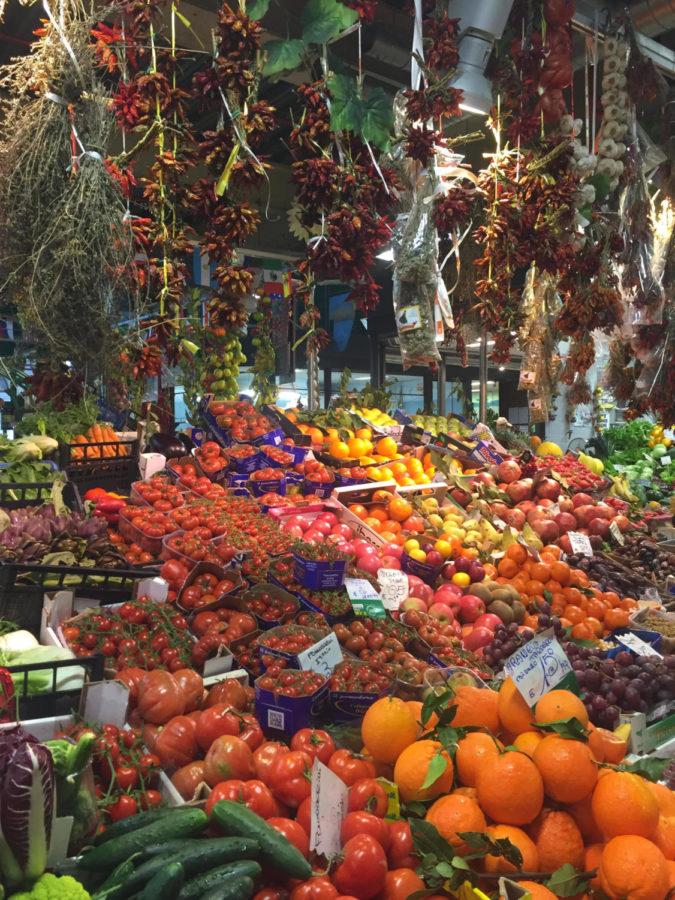Eating my way through Italy
Jenna Hrlicka/Iowa State Daily
Markets full of fresh foods are popular for daily meals.
March 8, 2016
Florence — capital of Italy’s Tuscany region, origin of the Renaissance and home to an endless variety of art and architectural masterpieces — is a city bursting with Italian culture.
I chose to study abroad in Florence to experience the culture, which is so rich in art, architecture and values of the Renaissance, and to experience firsthand the “Italian Way,” which encompasses a strong belief in living for the moment. The other reason I chose Florence was to chase the amazing food and wine the city is known for.
As a foodie at heart, the promise of endless pasta, pizza and wine captured my attention from the moment I started looking into studying abroad. After four weeks of life in Florence, I can say, without hesitation, that I wholeheartedly embraced the cuisine in the area. The best food in Florence is simple in nature, with a focus on fresh, locally grown ingredients.
Transitioning to the cuisine of a different culture is definitely an adventure. Here’s a breakdown of how my transition to the Italian diet has gone so far and an overview of things I’ve learned:
Be adventurous
Some of my favorite meals in Florence have been ones that I was initially unsure about. During a recent trip to an Osteria, I dined on fresh pasta smothered in a duck sauce followed by veal — which I never tried before — courtesy of the waiter’s recommendations. It was absolutely delicious, and ordering outside my comfort zone ultimately led to the discovery of one of my favorite dishes in Florence. Some adventures may lead to failure, like when I tried anchovy pizza for the first time, but you live and learn.
Buy for the day
Italians value quality, which often means buying fresh groceries the day they plan to use them. This is a bit different than the one grocery trip I take every week or two in Iowa. Buying in bulk is not common in Florence — especially not in the city center — where grocery stores are few and small. While this took some getting used to, stopping at the market to pick up fresh veggies and bread has become one of my favorite routines.
Budget
Budgeting is a necessity when it comes to eating abroad. It’s easy to get carried away and start spending large amounts of money in restaurants and specialty grocery stores. Budgeting allows me to know exactly how much I can spend on groceries for the week as well as how much I can splurge at a new restaurant or my favorite coffee shop.
Mealtimes
Adjusting to the typical Italian mealtimes has been one of the hardest challenges for me. Breakfast is almost nonexistent in Florence. A quick cappuccino and a croissant is the norm for locals. Lunchtime is about the same as it is in the United States, from around 11 a.m. to 2 p.m., and dinner is late. Restaurants typically do not even start serving dinner until around 7 or 8 p.m.
Miscellaneous changes
I have noticed various other changes in my personal diet since moving to Florence. I’m eating less meat, which may be because of the wonderful fresh fruits and vegetables or because I’m still terrified to order meat at the meat counters. Meat in Italy is delicious, but my sub-par Italian language skills make it a little difficult to know exactly what I’m buying.
I’m a firm believer in eating gelato as much as possible — if you travel to Florence, you must stop by Eduardo’s. My caffeine addiction is unreal. The coffee here is amazing. It is almost impossible not to enjoy a cappuccino in the mornings and a macchiato in the afternoon.
I’m still not sure if leftovers exist in the restaurants. I haven’t had any trouble finishing my meals — even the Neapolitan pizza that was larger than my plate — but the Italian tradition of eating multiple courses of pasta, pizza, salad, etc., never ceases to amaze me.
Food has the power to bring people together and has the potential to create bonds despite cultural differences. Transitioning to the eating habits and customs of a new culture can be difficult at times, but I highly recommend taking chances and trying to eat like the locals. It’s worth it.







